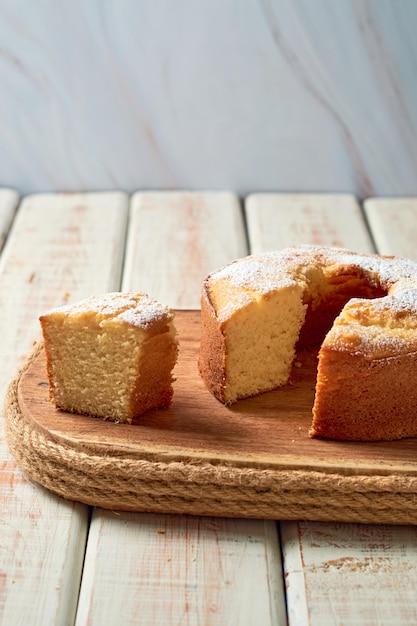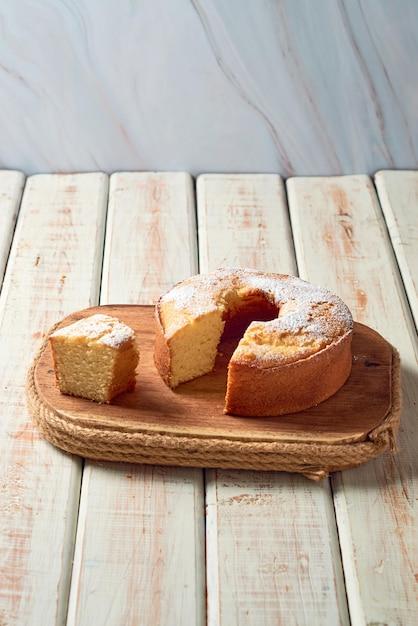Do you ever find yourself confused by the terms “Bundt cake” and “pound cake”? If so, you’re not alone! These two beloved classics share some similarities, but there are distinct characteristics that set them apart. In this blog post, we will dive into the wonderful world of Bundt cakes and pound cakes and explore their unique qualities, from baking techniques to flavor profiles.
Have you ever wondered how much batter to pour into a Bundt pan or whether you can use a regular cake mix for a Bundt cake? We’ve got you covered! We’ll also address common questions like whether to let a Bundt cake cool before flipping it, how to get a pound cake out of a Bundt pan, and why your pound cake may sometimes turn out wet in the middle.
So, whether you’re a baking enthusiast or just eager to satisfy your sweet tooth, grab your apron and join us on this delectable journey. Let’s unravel the differences between Bundt cakes and pound cakes and discover the secrets to creating these irresistible treats.
What Sets Them Apart: Exploring the Bundt Cake vs. Pound Cake Debate
The Great Divide: What’s the Difference Between a Bundt Cake and a Pound Cake
If you’ve ever found yourself mulling over the distinctions between a Bundt cake and a pound cake, you’re not alone in this confectionery conundrum. While both cakes share similar characteristics, they also have key features that set them apart. So, let’s dive right in and demystify the delightful debate!
The Classic Pound Cake: Rich, Dense, and Oh-So-Buttery
Ingredients and Texture:
Pound cakes are known for their rich, dense, and buttery nature. Traditionally, they are made with one pound each of flour, butter, sugar, and eggs—hence the name! The result? A velvety smooth texture that practically melts in your mouth.
Shape and Presentation:
When it comes to presentation, pound cakes are typically baked in a standard loaf pan or in individual portions as pound cake muffins. Their simple, yet elegant, shape makes them a versatile choice for any occasion.
Flavor Variations:
Pound cakes inherently have a neutral flavor profile, which allows them to be incredibly versatile. You can experiment with various add-ins, such as citrus zest, chocolate chips, nuts, or even tangy cream cheese, to infuse your pound cake with tantalizing flavors.
Enter the Bundt Cake: Sculpted Beauty with a Twist
Shape and Design:
What truly sets the Bundt cake apart is its iconic shape and intricately designed molds. These molds create a stunningly beautiful cake with a hole in the center. A slice of a well-baked Bundt cake provides an aesthetically pleasing experience that will undoubtedly make your taste buds tingle with anticipation.
Lighter Texture, Moist and Airy:
While the pound cake boasts a dense texture, the Bundt cake leans towards the lighter side. Thanks to its hollow center, heat is distributed evenly, resulting in a moist and airy crumb that’s hard to resist.
Flavor Combinations and Glazes:
Bundt cakes aren’t just about looks—they’re about exploring an array of flavors too! From zesty lemon to decadent chocolate, Bundt cakes can accomodate a wide range of flavors. They can be covered in sweet glazes, drizzled with fruit syrups, dusted with powdered sugar, or even adorned with a luscious cream cheese frosting.
So, Which Cake Wins the Battle
The real answer lies in your personal preference and the occasion at hand. If dense, buttery goodness is what you crave, the classic pound cake is your champion. However, if you desire an eye-catching centerpiece with a lighter, melt-in-your-mouth texture, the delightful Bundt cake gets the crown.
Bake Your Joy!
Whichever cake you choose, remember that baking is an art of self-expression. So, don your apron, fire up the oven, and indulge in the joy of whipping up a delicious treat for yourself or loved ones. Whether you’re a pound cake purist or a Bundt cake enthusiast, the act of baking itself is nothing short of pure bliss. Happy baking!
FAQ: What Is The Difference Between a Bundt Cake and a Pound Cake
How much batter do you put in a Bundt pan
When it comes to filling a Bundt pan, you should aim to fill it around two-thirds of the way full. This allows the cake to rise and bake evenly without overflowing. It’s important not to overfill the pan, as this can lead to a messy situation in your oven!
Are Bundt cakes and pound cakes the same
While both Bundt cakes and pound cakes are deliciously moist and rich, they are not exactly the same. The main difference lies in the pan used for baking. A Bundt cake is baked in a Bundt pan, which has a distinctive ring shape with fluted sides, while a pound cake can be baked in a variety of pans, including loaf and tube pans.
Should you let a Bundt cake cool before flipping it
Absolutely! After taking your Bundt cake out of the oven, it’s important to let it cool in the pan for about 10-15 minutes. This allows the cake to firm up and become less delicate. After the initial cooling period, gently flip the pan onto a wire rack or serving plate, tapping the bottom of the pan if needed, to release the cake beautifully.
How long should you let a pound cake cool in the pan
For that perfect pound cake texture, you should let your pound cake cool in the pan for about 10 minutes. This gives it time to set slightly, making it easier to remove from the pan without any mishaps. Once the 10-minute mark hits, carefully transfer the pound cake to a wire rack to cool completely.
Can you use regular cake mix in a Bundt pan
Absolutely! You can definitely use a regular cake mix to bake a delicious Bundt cake. Just be sure to follow the instructions on the cake mix box, adjust the baking time as needed, and enjoy the delightful results!
Can I use a Bundt pan instead of a tube pan for pound cake
Yes, you can certainly use a Bundt pan instead of a tube pan when making a pound cake. The two pans are quite similar, and the main difference is the decorative design on the Bundt pan. So go ahead and use whichever pan you have on hand, and get ready to indulge in a scrumptious pound cake!
What do you call the sides of a Bundt pan
The sides of a Bundt pan are referred to as “flutes.” These fluted sides give Bundt cakes their signature beautiful ring shape, allowing for an even distribution of heat and an elegant presentation. So when admiring your Bundt cake, you can appreciate both the delicious taste and the decorative flutes!
What is the purpose of a Bundt pan
The purpose of a Bundt pan goes beyond just creating a stunning looking cake. The unique design of a Bundt pan, with its center tube and fluted sides, allows for even heat distribution throughout the cake while promoting moistness. The tube in the center helps the cake bake evenly, and the fluted sides add a touch of decorative appeal.
Is it better to use cake flour or all-purpose flour for a pound cake
When it comes to choosing flour for a pound cake, either cake flour or all-purpose flour can be used. Cake flour will give you a more delicate and tender texture, while all-purpose flour will result in a slightly denser and more flavorful pound cake. It ultimately depends on your personal preference, so feel free to experiment and find the perfect balance for your taste buds!
Is pound cake better the next day
Oh, you bet! Pound cake actually improves in flavor and texture after sitting for a day or two. The flavors have a chance to meld together, resulting in a richer and more moist pound cake. So if you manage to resist devouring it all on the first day, treat yourself to a slice the next day for an even more delightful experience.
Do you have to flour a Bundt pan
Yes, it’s important to flour a Bundt pan to ensure easy release of the cake. Before adding your batter, generously grease the pan with butter or cooking spray, making sure to get into all the nooks and crannies. Then, lightly dust the entire surface with flour, tapping out any excess. This extra step will prevent your Bundt cake from sticking and make for a fuss-free removal.
Should I use bleached or unbleached flour for pound cake
Both bleached and unbleached flour can be used for making a delicious pound cake. The main difference lies in the texture and color of the final product. Bleached flour tends to produce a slightly softer and lighter pound cake, while unbleached flour may yield a denser cake with a slightly more substantial flavor. Ultimately, it’s a matter of personal preference and what you have available in your pantry.
Can you overbeat a pound cake
Well, it’s true that overbeating can be an issue with certain types of cakes, but pound cake is quite forgiving. The key is to beat the ingredients until just combined and no further. Overmixing can lead to a tougher texture, so keep an eye on your batter and exercise some self-control with that mixer!
Do you flip a Bundt cake right away
No, no, no! It’s best not to rush the flipping process when it comes to a Bundt cake. Let the cake rest in the pan for about 10-15 minutes after taking it out of the oven. This allows it to cool slightly and firm up, making it easier to release it from the pan in one lovely piece. Patience is key here!
How do you get a pound cake out of a Bundt pan
To elegantly extract your pound cake from a Bundt pan, start by gently running a butter knife or offset spatula along the edges of the pan to loosen the cake. Then, place a cooling rack or serving plate on top of the pan and firmly hold both the pan and the rack/plate together. In one swift motion, carefully flip them over, tapping the bottom of the pan to ensure a successful release. Lift the pan away, and voila! Your masterpiece is ready to be enjoyed.
Why is my pound cake wet in the middle
If you’ve noticed a frustratingly wet center in your pound cake, it could be due to a few reasons. Firstly, make sure you’ve baked the cake for the full recommended time. Underbaking can leave the center gooey. Secondly, check that your oven temperature is accurate and properly calibrated. Finally, be mindful of the pan size and shape. Using a different pan size or shape can affect the baking time and result in a poorly cooked center. So, keep those variables in mind and strive for that perfectly baked pound cake!
Do I have to use a Bundt pan for pound cake
Not at all! A Bundt pan is not a requirement for baking a pound cake. Traditional pound cakes can be baked in loaf pans, tube pans, or any other similar-shaped pans you may have in your kitchen. A Bundt pan may provide an elegant and decorative touch, but it’s certainly not mandatory for enjoying a scrumptious pound cake.
What is the best flour to use for pound cake
The best flour for your pound cake depends on the texture and flavor you desire. If you’re after a tender and delicate cake, cake flour is a great choice. However, if you prefer a slightly denser and more flavorful pound cake, all-purpose flour will serve you well. Trust your taste buds and go for the flour that satisfies your cravings!

